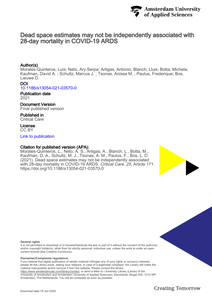BACKGROUND: Estimates for dead space ventilation have been shown to be independently associated with an increased risk of mortality in the acute respiratory distress syndrome and small case series of COVID-19-related ARDS.METHODS: Secondary analysis from the PRoVENT-COVID study. The PRoVENT-COVID is a national, multicenter, retrospective observational study done at 22 intensive care units in the Netherlands. Consecutive patients aged at least 18 years were eligible for participation if they had received invasive ventilation for COVID-19 at a participating ICU during the first month of the national outbreak in the Netherlands. The aim was to quantify the dynamics and determine the prognostic value of surrogate markers of wasted ventilation in patients with COVID-19-related ARDS.RESULTS: A total of 927 consecutive patients admitted with COVID-19-related ARDS were included in this study. Estimations of wasted ventilation such as the estimated dead space fraction (by Harris-Benedict and direct method) and ventilatory ratio were significantly higher in non-survivors than survivors at baseline and during the following days of mechanical ventilation (p < 0.001). The end-tidal-to-arterial PCO2 ratio was lower in non-survivors than in survivors (p < 0.001). As ARDS severity increased, mortality increased with successive tertiles of dead space fraction by Harris-Benedict and by direct estimation, and with an increase in the VR. The same trend was observed with decreased levels in the tertiles for the end-tidal-to-arterial PCO2 ratio. After adjustment for a base risk model that included chronic comorbidities and ventilation- and oxygenation-parameters, none of the dead space estimates measured at the start of ventilation or the following days were significantly associated with 28-day mortality.CONCLUSIONS: There is significant impairment of ventilation in the early course of COVID-19-related ARDS but quantification of this impairment does not add prognostic information when added to a baseline risk model.TRIAL REGISTRATION: ISRCTN04346342. Registered 15 April 2020. Retrospectively registered.
MULTIFILE

Background: Estimates for dead space ventilation have been shown to be independently associated with an increased risk of mortality in the acute respiratory distress syndrome and small case series of COVID-19-related ARDS. Methods: Secondary analysis from the PRoVENT-COVID study. The PRoVENT-COVID is a national, multicenter, retrospective observational study done at 22 intensive care units in the Netherlands. Consecutive patients aged at least 18 years were eligible for participation if they had received invasive ventilation for COVID-19 at a participating ICU during the first month of the national outbreak in the Netherlands. The aim was to quantify the dynamics and determine the prognostic value of surrogate markers of wasted ventilation in patients with COVID-19-related ARDS. Results: A total of 927 consecutive patients admitted with COVID-19-related ARDS were included in this study. Estimations of wasted ventilation such as the estimated dead space fraction (by Harris–Benedict and direct method) and ventilatory ratio were significantly higher in non-survivors than survivors at baseline and during the following days of mechanical ventilation (p < 0.001). The end-tidal-to-arterial PCO2 ratio was lower in non-survivors than in survivors (p < 0.001). As ARDS severity increased, mortality increased with successive tertiles of dead space fraction by Harris–Benedict and by direct estimation, and with an increase in the VR. The same trend was observed with decreased levels in the tertiles for the end-tidal-to-arterial PCO2 ratio. After adjustment for a base risk model that included chronic comorbidities and ventilation- and oxygenation-parameters, none of the dead space estimates measured at the start of ventilation or the following days were significantly associated with 28-day mortality. Conclusions: There is significant impairment of ventilation in the early course of COVID-19-related ARDS but quantification of this impairment does not add prognostic information when added to a baseline risk model. Trial registration: ISRCTN04346342. Registered 15 April 2020. Retrospectively registered.
DOCUMENT
This article focuses on engagements with elephants in diverse contexts, inquiring why some scholars are indifferent or even actively opposed to discourses that emphasise elephant suffering. In order to address this question, this article will explore three interrelated streams within social science: one that criticises conservation as an elitist, neo-colonial enterprise; one that is preoccupied with the social construction and cultural interpretation of natural phenomenon; and a third sometimes referred to as the new conservation science that focuses on economic valuations of the benefits nature, viewing “nature is a warehouse for human use.” https://doi.org/10.1080/13880292.2016.1204882 LinkedIn: https://www.linkedin.com/in/helenkopnina/
MULTIFILE
